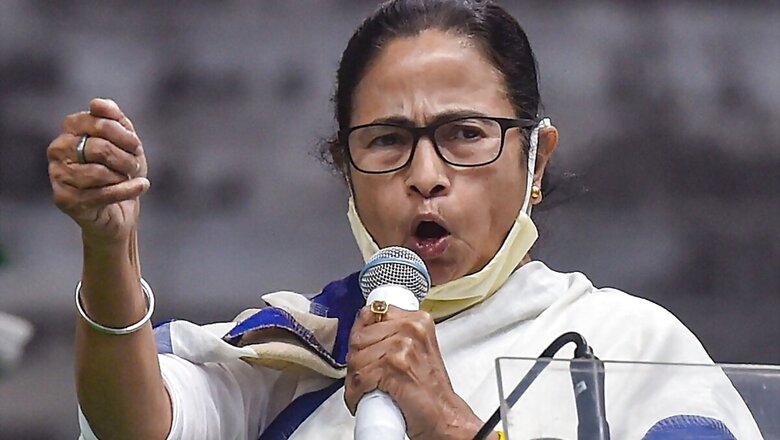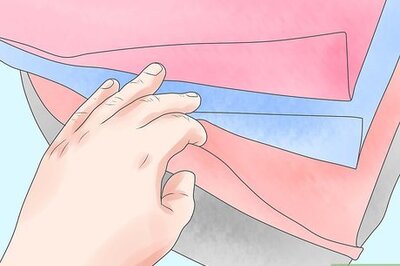
views
From Bihar, now the wind of elections has reached West Bengal and all eyes are on Mamata Banerjee and Prime Minister Narendra Modi. The biggest question of the year will be on whose head Bengal will put the crown? But who will grab the power and whose hand power will slip away from will be determined by who is promising what to the hoi polloi at large.
Just before the elections, political parties open the pandora’s box that contains promises and inducements. Mamta’s ‘Maa Scheme’ is one such programme under which the promise has been made to offer cheap meal, poor will be embraced and this would make Mamta win the elections in the state (sasta bhojan, gareeb se yaaree ab bangaal kee baaree).
Mamata Banerjee has taken ‘Maa’ from her party’s slogan ‘Maan, Maati and Maanush’ to name this scheme. The scheme has been started from Kolkata which will have 16 common kitchens, which will offer a thali that will cost merely ₹5. This ‘thali’ (plate) will contain rice, lentil, vegetable and egg. The Government intends to slowly implement this scheme in other cities of the State as well.
From South to North, wherever the election strategist, Prashant Kishor, has gone, he has given the idea to initiate such schemes. The first such scheme was announced by former Chief Minister Jayalalitha in Tamil Nadu and had started ‘Amma Kitchen’ in her State.
When Prashant Kishor was making strategy for the Congress in the UP elections in 2017, Samajwadi Party and Congress had fought the elections together. At that time, the then Chief Minister Akhilesh Yadav had announced that if his coalition wins the elections then they too will start ‘Samajwadi Kitchen’, something like Amma Kitchen in his State.
Since the election is round the corner, so fingers will be raised at the schemes of Mamata Banerjee’s government. But it is to be remembered that during the lockdown, community kitchen had played a major role. Millions of people were fed through the community kitchen for free. Today, many State governments are running such schemes.
The main aim of such a scheme is to provide meals to the poor on cheaper rates with full nourishments. Though the first person to advance the idea of community kitchen some 100 years ago, was none other than Mahatma Gandhi.
Mahatma Gandhi used to say that cooking food should be a part of our educational curriculum. After he returned from South Africa, when he visited Shanti Niketan for the first time, he did not like the ways of the students there. He felt that apart from study, students should also do their own work. On March 10, 1915, with the consent of Rabindra Nath Tagore, Mahatma Gandhi started a self-help movement. Under this a community kitchen was also started in which all students used to cook in batches.
Jayalalitha is the pioneer
It was Tamil Nadu government which had started Amma Unavagam on February 19, 2013 which was also famous as Amma Canteen. Under this scheme, the municipal corporations of the State were providing subsidised meals to the people. In these canteens, one gets idli for ₹1, Sanbhar and rice for ₹5 and curd and rice is provided for ₹3 per plate.
After Tamil Nadu, many other States replicated this. This includes Karnataka, Telangana, Maharashtra and Odisha where governments started community kitchens.
Indira Canteen in Karnataka
Siddaramaiah, the former Chief Minister of Karnataka, had started Indira Canteen to provide low-cost meals thrice a day to the urban poor. On August 16, 2017, the Congress leader Rahul Gandhi had inaugurated this scheme in Bengaluru. Later, this scheme was also launched in Mysuru, Mangalore, Shimoga, Hubli and Kalburgi.
Shiv Bhojan scheme in Maharashtra
The Maharashtra government started Shiv Bhojan Scheme on January 26, 2020. Under this scheme, people are provided meals for ₹10. During the lockdown, the cost of this meal was reduced to ₹5. Under this scheme, the plate of meal contains two chapatis, one type of vegetable, rice and lentil.|
Annapurna Scheme in Telangana
The Annapurna scheme was launched in Telangana in 2014. Under this scheme, the Greater Hyderabad Municipal Corporation provides one plate meal for ₹5. This scheme was launched in eight places initially, but now it has 150 such centres running throughout the State and 25,000 people are provided cheap ready-to-eat meals through this scheme.
NTR Canteen in Andhra Pradesh
In Andhra Pradesh, the then Chief Minister Chandrababu Naidu started the NTR Canteen. Under this cheap meal scheme, people were provided breakfast, midday meal, and dinner. The breakfast was available for ₹5 and meal was available for ₹15 per plate. But in 2019, the Chief Minister YS Jagan Mohan Reddy’s government closed down this scheme.
During the lockdown, its ambit increased
Apart from these States, many other States also started such schemes. Especially during the Corona pandemic when the lockdown was announced, many States provided the cooked meal to the people free of cost. Even States like Jharkhand and Bihar provided free meals to the people during the lockdown.
It may be that the schemes of providing cooked food on cheaper rates were started just eight years ago, but the Centre has been providing the food grains to the poor people from much earlier. Under the National Food Security Act, they aim to provide cheap food grains to 75% population in rural areas and 50% in urban areas.
History of Community Kitchens
The history of the community kitchen is as old as the history of the Sikh religion. In 15th century, the founder of the Sikh religion, Guru Nanak Dev had started the langar or the community kitchen. Langar is a Persian word which means shelter for the poor. The langar organised all over the country, is the best example of the community kitchen.
Global Hunger Index
The Global Hunger Index of the year 2020 has a total of 107 countries and India is placed on 94th position in this index. As per the data available, India’s 14% population is malnourished. According to the GHI data, India’s neighbours Bangladesh, Myanmar and Pakistan are better placed in this index than India. This tells that India needs more community kitchens to feed its poor and malnourished.
Read all the Latest News, Breaking News and Coronavirus News here
















Comments
0 comment